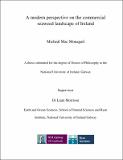A modern perspective on the commercial seaweed landscape of Ireland

View/
Date
2021-08-24Author
Mac Monagail, Michéal
Metadata
Show full item recordUsage
This item's downloads: 419 (view details)
Abstract
In Ireland, seaweed was historically commercially used as a raw material to produce
high-volume, low-value commodities, mostly animal feed. More recently, and due to the
increasing mainstream acceptance of seaweed, there has been a renewed vigour in the
Irish seaweed industry. The harvesting and gathering of “wild” seaweeds continue to
play an integral role in many coastal societies, often being intrinsically linked to the
cultural identity of those coastal communities. However, given the increasing
commercial interest in seaweed, certainly now at a point greater than at any stage in
Irish history, it is critically important that the sustainability of the resource is ensured.
This thesis describes themes important to the continued evolution of the Irish seaweed
commercial landscape. Chapters 2 and 3 focus first on the seaweed resources of Irish
waters and how the seaweed industry has changed, adapted, and progressed in the 21st
century. The second part (Chapters 4 and 5) focuses on the potential issues relating to
levels of arsenic in seaweed. Seaweed has a long history of use as a supplemented
livestock feed, providing nutrients and vitamins essential to maintaining animal health.
However, seaweeds such as Ascophyllum nodosum are well-known accumulators of the
metalloid arsenic. As the global demand for livestock produce grows, there exists
concern that consumption of livestock produce reared on a diet supplemented with
seaweed may pose a threat to the human population due to the potential transfer of
naturally occurring arsenic present in seaweed. A population-exposure assessment was
carried out using arsenic data from a commercially available seaweed meal from 2012 to
2017. A “Monte Carlo” simulation model was developed to characterise the feed to food
transfer of Arsenic from animal feed to animal produce such as beef, milk, chicken, and
eggs. To further address potential concerns and provide end-users, including industry,
consumers, policymakers, and regulators, with information on the exposure associated
with arsenic in commercial seaweed animal feed, the estimated daily intake of arsenic
was calculated to evaluate potential human exposure levels. Chapters 6 and 7 describe
the use of “Earth Observation” technologies to monitor some native and invasive
seaweed blooming species in eutrophic North-East Atlantic estuaries and reconstruct the
historical development of seaweeds using free-to-access satellite imagery (Landsat and Sentinel) utilising appropriate modelling to express the influence of environmental
factors on bloom-forming seaweed development. Studies described in Chapters 6 and 7
are the first to utilise satellite imagery to reconstruct the historical development of
blooms in European waters. Finally, in Chapter 8, a general discussion of the thesis is
provided, concluding the thesis's primary findings while providing recommendations
supporting the continued development of Ireland's commercial seaweed industry.
Collections
Except where otherwise noted, this item's license is described as Attribution-NonCommercial-NoDerivs 3.0 Ireland
Related items
Showing items related by title, author, creator and subject.
-
Linking soil pH and phosphorus management to potential N2O emissions and nitrogen cycling microbial communities
Grau Butinyac, Meritxell (NUI Galway, 2022-08-15)Greenhouse gases (GHGs) in the atmosphere create the greenhouse gas effect, which allows maintenance of global temperatures. However, anthropogenic production of GHGs has caused dramatic increases of GHGs in the ... -
Microplastics in the marine environment: analytical considerations, emerging sources, and protocol validation
Mendes, Ana Rita Marques (NUI Galway, 2024-02-02)Microplastics particles, with a size range between 1µm to 5 mm are established in all ecosystems, from the poles to the equator, and in a wide range of organisms including mammals, birds, fish, and invertebrates. ... -
Fractionation of whey protein glycosylation and assessment of prebiotic and immunomodulation bioactivities for valorisation
Asadi Shehni, Akram (NUI Galway, 2021-03-15)Functional foods are defined as food components that, in addition to their nutritional value, improve human health and/or decrease the risk of diseases. Probiotics, ingested live beneficial bacteria, and prebiotics, the ...

